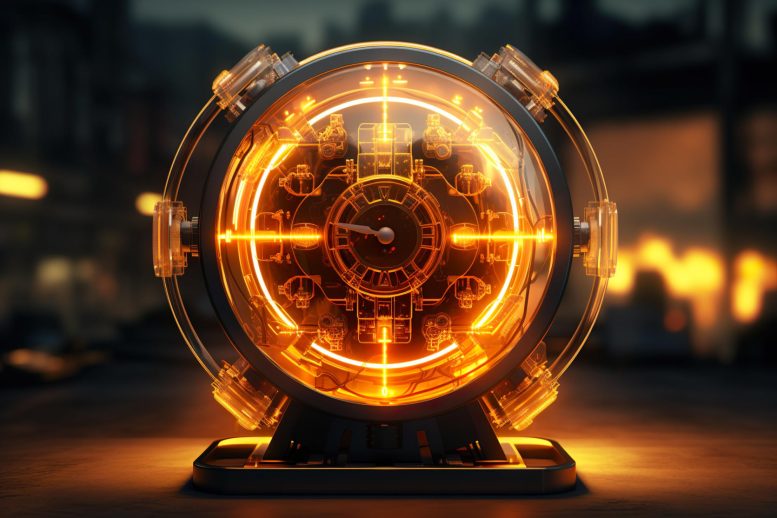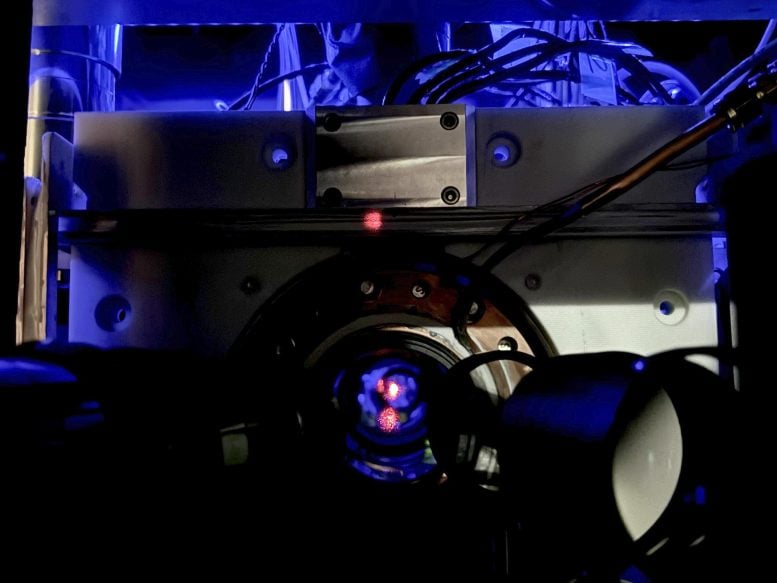
JILA researchers have created the most precise atomic clock yet, using visible light for time measurement. This breakthrough could redefine timekeeping standards and unlock new insights in physics, aiding both space exploration and quantum computing.
In humanity’s relentless quest for perfection, scientists have created an atomic clock that surpasses all previous clocks in precision and accuracy. Developed by researchers at JILA, a joint institution of the National Institute of Standards and Technology (NIST) and the University of Colorado Boulder, this new clock represents a significant advancement in timekeeping technology.
Enabling pinpoint navigation in the vast expanse of space and searching for new particles, this clock is the latest to transcend mere timekeeping. With their increased precision, these next-generation timekeepers could reveal hidden underground mineral deposits and test fundamental theories such as general relativity with unprecedented rigor. For atomic clock architects, it’s not just about building a better clock; it’s about unraveling the secrets of the universe and paving the way for technologies that will shape our world for generations to come.
The worldwide scientific community is considering redefining the second, the international unit of time, based on these next-generation optical atomic clocks. Existing-generation atomic clocks shine microwaves on atoms to measure the second. This new wave of clocks illuminates atoms with visible light waves, which have a much higher frequency, to count out the second much more precisely. Compared with current microwave clocks, optical clocks are expected to deliver much higher accuracy for international timekeeping — potentially losing only one second every 30 billion years.
But before these atomic clocks can perform with such high accuracy, they need to have very high precision; in other words, they must be able to measure extremely tiny fractions of a second. Achieving both high precision and high accuracy could have vast implications.
Trapped in Time
The new JILA clock uses a web of light known as an “optical lattice” to trap and measure tens of thousands of individual atoms simultaneously. Having such a large ensemble provides a huge advantage in precision. The more atoms measured, the more data the clock has for yielding a precise measurement of the second.

To achieve new record-breaking performance, the JILA researchers used a shallower, gentler “web” of laser light to trap the atoms, compared with previous optical lattice clocks. This significantly reduced two major sources of error — effects from the laser light that traps the atoms, and atoms bumping into one another when they are packed too tightly.
The researchers describe their advances in Physical Review Letters.
Clocking Relativity on the Smallest Scales
“This clock is so precise that it can detect tiny effects predicted by theories such as general relativity, even at the microscopic scale,” said NIST and JILA physicist Jun Ye. “It’s pushing the boundaries of what’s possible with timekeeping.”
General relativity is Einstein’s theory that describes how gravity is caused by the warping of space and time. One of the key predictions of general relativity is that time itself is affected by gravity — the stronger the gravitational field, the slower time passes.
This new clock design can allow the detection of relativistic effects on timekeeping at the submillimeter scale, about the thickness of a single human hair. Raising or lowering the clock by that minuscule distance is enough for researchers to discern a tiny change in the flow of time caused by gravity’s effects.
This ability to observe the effects of general relativity at the microscopic scale can significantly bridge the gap between the microscopic quantum realm and the large-scale phenomena described by general relativity.
Navigating Space and Quantum Advances
More precise atomic clocks also enable more accurate navigation and exploration in space. As humans venture farther into the solar system, clocks will need to keep precise time over vast distances. Even tiny errors in timekeeping can lead to navigation errors that grow exponentially the farther you travel.
“If we want to land a spacecraft on Mars with pinpoint accuracy, we’re going to need clocks that are orders of magnitude more precise than what we have today in GPS,” said Ye. “This new clock is a major step towards making that possible.”
The same methods used to trap and control the atoms could also produce breakthroughs in quantum computing. Quantum computers need to be able to precisely manipulate the internal properties of individual atoms or molecules to perform computations. The progress in controlling and measuring microscopic quantum systems has significantly advanced this endeavor.
By venturing into the microscopic realm where the theories of quantum mechanics and general relativity intersect, researchers are cracking open the door to new levels of understanding about the fundamental nature of reality itself. From the infinitesimal scales where the flow of time becomes distorted by gravity, to the vast cosmic frontiers where dark matter and dark energy hold sway, this clock’s exquisite precision promises to illuminate some of the universe’s deepest mysteries.
“We’re exploring the frontiers of measurement science,” Ye said. “When you can measure things with this level of precision, you start to see phenomena that we’ve only been able to theorize about until now.”
Reference: “Clock with 8×10−19 Systematic Uncertainty” by Alexander Aeppli, Kyungtae Kim, William Warfield, Marianna S. Safronova and Jun Ye, 10 July 2024, Physical Review Letters.
DOI: 10.1103/PhysRevLett.133.023401
3 Comments
Redefining Time and Space.
Very good.
Please ask researchers to think deeply:
Do you truly understand time and space?
If you are truly interested in science, you can browse https://zhuanlan.zhihu.com/p/695926158.
Scientific research guided by correct theories can help humanity avoid detours, failures, and pomposity. Will your knowledge, breakthroughs, and even redefining be a joke in the public eye? Please witness the exemplary collaboration between theoretical physicists and experimentalists (https://scitechdaily.com/microscope-spacecrafts-most-precise-test-of-key-component-of-the-theory-of-general-relativity/#comment-854286). Is this the children’s story of contemporary physics?
Redefining Time and Space.
Very good.
Please ask researchers to think deeply:
Do you truly understand time and space?
Scientific research guided by correct theories can help humanity avoid detours, failures, and pomposity. Please witness the exemplary collaboration between theoretical physicists and experimentalists (https://scitechdaily.com/microscope-spacecrafts-most-precise-test-of-key-component-of-the-theory-of-general-relativity/#comment-854286). Is this the children’s story of contemporary physics?
The absolute and relative unity of time and space constitutes the material basis of Special Relativity, which has no interval between time and space. If you are truly interested in science, you can browse https://zhuanlan.zhihu.com/p/695926158.
I do not hold a degree from the academic world,but have attended college taking a few courses on occasion.Firstly the author and experimentalists of topic discussed explains that this endeavor into measuring TIME could help us in our present ongoing attempt at improving quantum physics,yet fail to recognize that the act
itself of reaching into more infinite measurements of TIME;in and of itself;is quantum physics.In their search for improving TIME they are moving forward in quantum physics;TIME is one of the glu-oned constants of quantum physics.I hope they realize they are resolving both objectives with one applied experiment.This scientific endeavour is vital to the future of all scientific fields.Long overdue.I have come up with many ideas while reading this article that can further the precision of improving the TIME precisnise.Since I was a quality control specialist in my occupation I was geared to think that way.Good accomplishment but we can go further still.I have some new concepts and some that are open ended that you can add on in the near future as needed.Get in touch with me if you so wish.